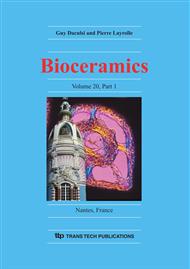p.1107
p.1111
p.1115
p.1119
p.1123
p.1127
p.1131
p.1135
p.1139
Is Hydroxyapatite Ceramic Included in the Bone Remodelling Proccess? An In Vitro Study of Resorption and Formation Processes
Abstract:
Bone remodelling is a coupled process of bone formation and resorption. This process is physiologically controlled and involves the synthesis of bone matrix by osteoblasts and bone resorption by giant cells called osteoclasts. It includes a complex interaction of cells, with specific chemokine signalling. In order to study bone remodelling in vitro, we cultivated two precursor cellline types in a model coculture system on synthetic hydroxyapatite ceramic (HA) for 14 days. The monocytes have the capacity to differentiate into osteoclast-like cells, and the bone marrow stromal cells can differentiate into osteoblast-like cells. This coculture was used to analyse the in vitro cell interaction between monocytes and stromal cells. Furthermore, the attachment of the bone marrow stromal cells to the resorbed HA-surfaces was studied. In this in vitro study we demonstrated osteoclast-like differentiation and bone marrow stromal growth in a coculture system on a synthetic bone substitute material. Under optimal conditions, HA can be resorbed and bone marrow cells can grow into the lacunas to form new bone. These results give important cues for the adjustment of synthetic bone substitute materials for optimal remodelling behaviour.
Info:
Periodical:
Pages:
1123-1126
Citation:
Online since:
November 2007
Authors:
Keywords:
Price:
Сopyright:
© 2008 Trans Tech Publications Ltd. All Rights Reserved
Share:
Citation:


